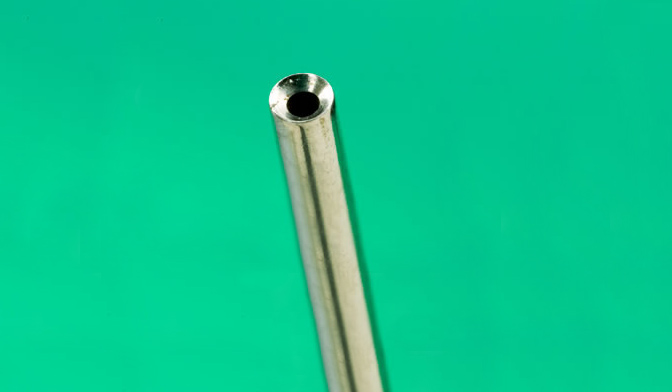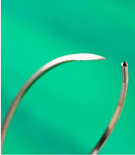
These premium grade needles from our expert team here at Barber of Sheffield are different to majority of drilled end suture needles from other suppliers.
|
|
The processes we use to create our premium needles are far superior to competitors manufacturing methods. For example, many companies will attempt to reduce drilling costs by using high sulphur “free cutting grade” of stainless steel conforming to AISI 420 F regulations. By using this raw material, they are introducing numerous deficiencies and issues with their products. This includes reduced ductility and minimal corrosion resistance. However, the drilled needles produced by Barber of Sheffield are made from the same grade of medical stainless steel as many of the highest quality surgical instruments and equipment. The raw material for these needles is martensitic grade stainless steel conforming to DIN Werkstoffnummer 1.4031. In the case of ophthalmic and certain specialty needles, maraging grade to AISI 455 is used. Many other companies anneal the drilled end of the needle, which helps to eliminate the possibility of cracking during the swaging process. This is a common problem with free cutting grade of steel. Here at Barber of Sheffield, our needles are uniformly hardened and tempered to a specific level. This controlled hardness of VPN 525 to 625 ensures adequate stiffness to withstand the pressure encountered in the suturing procedure while eliminating the issues of brittleness. Annealing of the drilled end of needles gives the unwanted effect of creating a discontinuous grain structure. This impairs the strength and corrosion resistance of the needle, making it an inferior product to the needles produced by Barber of Sheffield. In our drilled needles, the end is uniformly hardened with the main body of the needle. This means that the metallurgy and micro-structure of the needle in its entirety is uniform. This helps make it much more sturdy and strong. An additional advantage of the drilled end being hardened is the resulting improved suture grip which is obtained after the swaging process. This requires a higher swaging force and means that you can gain a higher pull-out strength. This is not possible with the annealed process of creating needles. Barber of Sheffield drilled needles are formed with a funnel shaped counter-bore. This helps to facilitate the suture inserting during the swaging process. However this also obviates the risk of suture “cut-through” in the swaging phase. The outer surface of the drilled end needle is also chamfered. This additional step ensures that any sharp edges at the swaged end are eliminated. Barber of Sheffield are dedicated to providing high quality products to their customers. This is the reason we never skimp on our manufacturing processes to cut our costs. We know that supplying reliable and consistently premium grade needles products is a vital part of our business. The raw material used in these drilled end needles is of a restricted specification grade. This is carbon controlled to 0.32 % minimum and Chromium 12.5 % minimum. Despite the fact that using the restricted specification adds considerably to the cost of raw material, as well as to the processing cost, Barber of Sheffield are committed to using this technique. This is because the resulting needle product combines high stiffness with high ductility. It also means that a drilled needle manufactured in this way will withstand bending through a sharp 90 degree angle without breaking. Our needles are polished to help minimise micro asperities on the surface by a series of mechanical polishing operations. This is then followed by additional electro polishing. These processes help to reduce the level of drag through the tissue during the suturing operation. Here at Barber of Sheffield, through extensive research and product development we have created a unique point geometry for cutting edge needles. This has a convex curved profile from the tip of the point to the widest part of the point. This specialised structure combines the advantage of the higher effective point angle right at the tip, which is strong and resistant to feathering, with a progressively reducing angle towards the widest part of the point. The combination of these two aspects results in excellent penetration characteristics. The point grinding is carried out on digitally controlled precision machines to ensure consistency and uniformity throughout the product line. We take the quality and performance of our needles very seriously here at Barber of Sheffield. Due to this level of commitment, there are strict quality control protocols and procedures carried out at each individual stage of the manufacturing process. These tests and checks include sharpness testing which is performed with a specially designed digital sharpness comparator. The highly accurate machine measures the force in grams required for penetrating a diaphragm which mimics the characteristics of skin. This is made from polyurethane standardised synthetic material as a tissue substitute. The stiffness of the needles is also measured with a special digital tester which enables the force versus displacement of the needle to be plotted numerically. This also determines whether the needle has regained its original shape without any permanent set. Our drilled needles also have the additional option of being created with a ribbed body. This helps to increase the stiffness and improve the stability in the needle holder. You may also be interested in drilled needles with a silicone coating. This is formed from a polysilaxane coating with Dow Corning MDX4- 4159 grade silicone. It is duly cured to give a stable lubricant coating which considerably improves the penetration characteristics of the drilled needles. |








